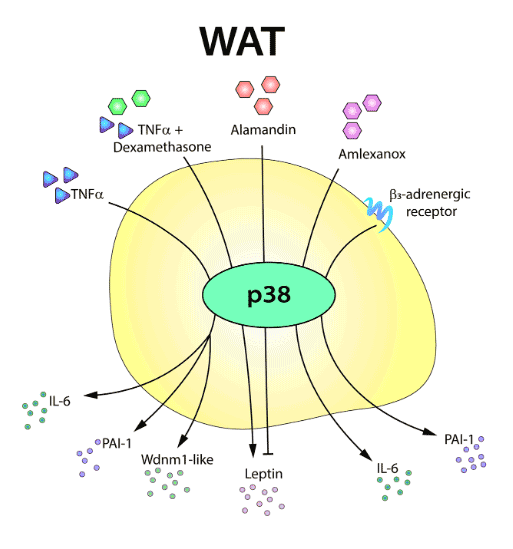Vítor Ferreira, Cintia Folgueira, Maria Guillén, Pablo Zubiaur, Marcos Navares, Assel Sarsenbayeva, Pilar López Larrubia, Jan W. Eriksson, Maria J. Pereira, Francisco Abad-Santos, Guadalupe Sabio, Patricia Rada & Ángela M. Valverde.
Second-generation antipsychotics (SGAs) are a mainstay therapy for schizophrenia. SGA-treated patients present higher risk for weight gain, dyslipidemia and hyperglycemia. Herein, we evaluated the effects of olanzapine (OLA), widely prescribed SGA, in mice focusing on changes in body weight and energy balance. We further explored OLA effects in protein tyrosine phosphatase-1B deficient (PTP1B-KO) mice, a preclinical model of leptin hypersensitivity protected against obesity.
Wild-type (WT) and PTP1B-KO mice were fed an OLA-supplemented diet (5 mg/kg/day, 7 months) or treated with OLA via intraperitoneal (i.p.) injection or by oral gavage (10 mg/kg/day, 8 weeks). Readouts of the crosstalk between hypothalamus and brown or subcutaneous white adipose tissue (BAT and iWAT, respectively) were assessed. The effects of intrahypothalamic administration of OLA with adenoviruses expressing constitutive active AMPKα1 in mice were also analyzed.
Both WT and PTP1B-KO mice receiving OLA-supplemented diet presented hyperphagia, but weight gain was enhanced only in WT mice. Unexpectedly, all mice receiving OLA via i.p. lost weight without changes in food intake, but with increased energy expenditure (EE). In these mice, reduced hypothalamic AMPK phosphorylation concurred with elevations in UCP-1 and temperature in BAT. These effects were also found by intrahypothalamic OLA injection and were abolished by constitutive activation of AMPK in the hypothalamus. Additionally, OLA i.p. treatment was associated with enhanced Tyrosine Hydroxylase (TH)-positive innervation and less sympathetic neuron-associated macrophages in iWAT. Both central and i.p. OLA injections increased UCP-1 and TH in iWAT, an effect also prevented by hypothalamic AMPK activation. By contrast, in mice fed an OLA-supplemented diet, BAT thermogenesis was only enhanced in those lacking PTP1B. Our results shed light for the first time that a threshold of OLA levels reaching the hypothalamus is required to activate the hypothalamus BAT/iWAT axis and, therefore, avoid weight gain.
Our results have unraveled an unexpected metabolic rewiring controlled by hypothalamic AMPK that avoids weight gain in male mice treated i.p. with OLA by activating BAT thermogenesis and iWAT browning and a potential benefit of PTP1B inhibition against OLA-induced weight gain upon oral treatment.







